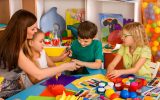Poverty, homelessness, a disability, and mental health disorders are known risk factors for children and teens. However, kids don’t have to be disadvantaged to be susceptible to risky behaviors that threaten their future health and well-being. Kids and teens need activities that make them feel valued, useful, confident, and self-sufficient, enabling them to stick to the positive values they’ve been taught at home and to resist bad influences.
If you’re looking for activities to pull your tween or teen back from the brink of risky behavior that could threaten their future, here are 10 of the best activities for at-risk youth.
Volunteering
Doing something to make a difference in the world allows children or teens to see new places, meet new people, and form friendships with the people they work alongside. Volunteering not only helps troubled kids but also benefits organizations in need.
Taking Care of Animals
Working with animals can be a great activity for at-risk children, especially when they’re allowed to form a bond with an animal that needs their help. Caring for animals also teaches kids about responsibility.
Helping the Elderly
Engaging with seniors teaches kids to care about other people. For children or teens who are having trouble fitting in at school or just need a distraction from negative peer influence, volunteering with senior communities can provide them with some structure and socialization.
Teaching Others
Sharing special talents or skills through teaching others is a great activity that will help teens feel useful. Taking on the responsibilities of a teaching role motivates youth about school and future career paths while boosting confidence and self-esteem.
Journaling
Journaling is a great way for troubled teens to productively express their feelings. Writing fosters communication skills and gives at-risk children or teenagers the chance to express themselves without fear of judgment or ridicule. Supporting positive self-expression is a form of empowering at-risk youth that shows acceptance, respect, and appreciation for their individuality.
Art Therapy
Making art is a safe way to articulate frustration and fears. Art therapy benefits troubled youths by facilitating communication of important messages about the struggles they’re facing.
Band, Chorus, or Orchestra
Getting kids involved in their school’s music programs has a demonstrated positive effect on academic outcomes. Playing music with others builds teamwork and a sense of belonging.
Gardening
Gardening provides a healthy way for kids to connect with nature while learning practical skills. Successfully growing vegetables and flowers builds self-esteem and encourages physical activity.
Running
Running burns off restless energy, builds physical fitness, and makes kids feel stronger and more confident. Running give kids at risk of being bullied an outlet, and joining a running team or club helps children struggling with feelings of isolation connect with others who may feel the same way.
Outdoor Recreation
Visiting forest preserves, parks, and wildlife sanctuaries gives children or teenagers an escape from boredom, depression, and hopelessness. Getting out into nature has been shown to be so beneficial to physical and mental health that doctors sometimes even prescribe a course of “forest bathing.” This practice, called shinrin-yoku in Japan, where it originated, clears the mind, sharpens the senses, and reduces stress. These 10 best activities for at-risk youth develop the communication, leadership, and life skills they need to grow up healthy and happy. Kids may discover activities that become sources of joy and motivation to live healthier lives, equipping them with improved social skills, bolstered self-esteem, greater self-efficacy, and increased academic achievement.













